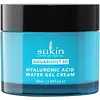What's inside
What's inside
 Key Ingredients
Key Ingredients

 Benefits
Benefits

 Concerns
Concerns

No concerns
 Ingredients Side-by-side
Ingredients Side-by-side

Aloe Barbadensis Leaf Juice
Skin ConditioningWater
Skin ConditioningIsoamyl Laurate
EmollientPropanediol
SolventOctyldodecanol
EmollientHydroxyethyl Acrylate/Sodium Acryloyldimethyl Taurate Copolymer
Emulsion StabilisingCucumis Sativus Fruit Water
Skin ConditioningSaccharide Isomerate
HumectantAllantoin
Skin ConditioningCamellia Sinensis Leaf Extract
AntimicrobialCannabis Sativa Seed Extract
EmollientLeptospermum Scoparium Branch/Leaf Oil
TonicPiper Nigrum Seed Extract
RefreshingMagnolia Officinalis Bark Extract
AntimicrobialCitrus Grandis Seed Extract
AstringentPhenoxyethanol
PreservativeSodium Benzoate
MaskingCitric Acid
BufferingSodium Citrate
BufferingEthylhexylglycerin
Skin ConditioningAloe Barbadensis Leaf Juice, Water, Isoamyl Laurate, Propanediol, Octyldodecanol, Hydroxyethyl Acrylate/Sodium Acryloyldimethyl Taurate Copolymer, Cucumis Sativus Fruit Water, Saccharide Isomerate, Allantoin, Camellia Sinensis Leaf Extract, Cannabis Sativa Seed Extract, Leptospermum Scoparium Branch/Leaf Oil, Piper Nigrum Seed Extract, Magnolia Officinalis Bark Extract, Citrus Grandis Seed Extract, Phenoxyethanol, Sodium Benzoate, Citric Acid, Sodium Citrate, Ethylhexylglycerin
Water
Skin ConditioningIsoamyl Laurate
EmollientCetearyl Alcohol
EmollientGlycerin
HumectantBetaine
HumectantCetyl Alcohol
EmollientNiacinamide
SmoothingPanthenol
Skin ConditioningHydrolyzed Sodium Hyaluronate
Skin ConditioningSodium Hyaluronate
HumectantSodium Acetylated Hyaluronate
HumectantSodium Hyaluronate Crosspolymer
HumectantCeramide Ng
Skin ConditioningHibiscus Esculentus Fruit Extract
Skin ConditioningXylitylglucoside
HumectantAnhydroxylitol
HumectantXylitol
HumectantTriolein
Skin ConditioningSaccharide Isomerate
HumectantSodium Polyglutamate
HumectantErythritol
HumectantTocopherol
AntioxidantOlea Europaea Fruit Oil
MaskingHelianthus Annuus Seed Oil
EmollientRicinus Communis Seed Oil
MaskingVegetable Oil
Skin ConditioningStearyl Alcohol
EmollientPentylene Glycol
Skin ConditioningBehentrimonium Methosulfate
Ethylhexylglycerin
Skin ConditioningCaprylyl Glycol
EmollientPhenoxyethanol
PreservativeSodium Metabisulfite
AntioxidantSodium Citrate
BufferingCitric Acid
BufferingParfum
MaskingLimonene
PerfumingLinalool
PerfumingWater, Isoamyl Laurate, Cetearyl Alcohol, Glycerin, Betaine, Cetyl Alcohol, Niacinamide, Panthenol, Hydrolyzed Sodium Hyaluronate, Sodium Hyaluronate, Sodium Acetylated Hyaluronate, Sodium Hyaluronate Crosspolymer, Ceramide Ng, Hibiscus Esculentus Fruit Extract, Xylitylglucoside, Anhydroxylitol, Xylitol, Triolein, Saccharide Isomerate, Sodium Polyglutamate, Erythritol, Tocopherol, Olea Europaea Fruit Oil, Helianthus Annuus Seed Oil, Ricinus Communis Seed Oil, Vegetable Oil, Stearyl Alcohol, Pentylene Glycol, Behentrimonium Methosulfate, Ethylhexylglycerin, Caprylyl Glycol, Phenoxyethanol, Sodium Metabisulfite, Sodium Citrate, Citric Acid, Parfum, Limonene, Linalool
Ingredients Explained
These ingredients are found in both products.
Ingredients higher up in an ingredient list are typically present in a larger amount.
Citric Acid is an alpha hydroxy acid (AHA) naturally found in citrus fruits like oranges, lemons, and limes.
Like other AHAs, citric acid can exfoliate skin by breaking down the bonds that hold dead skin cells together. This helps reveal smoother and brighter skin underneath.
However, this exfoliating effect only happens at high concentrations (20%) which can be hard to find in cosmetic products.
Due to this, citric acid is usually included in small amounts as a pH adjuster. This helps keep products slightly more acidic and compatible with skin's natural pH.
In skincare formulas, citric acid can:
While it can provide some skin benefits, research shows lactic acid and glycolic acid are generally more effective and less irritating exfoliants.
Most citric acid used in skincare today is made by fermenting sugars (usually from molasses). This synthetic version is identical to the natural citrus form but easier to stabilize and use in formulations.
Read more about some other popular AHA's here:
Learn more about Citric AcidEthylhexylglycerin (we can't pronounce this either) is commonly used as a preservative and skin softener. It is derived from glyceryl.
You might see Ethylhexylglycerin often paired with other preservatives such as phenoxyethanol. Ethylhexylglycerin has been found to increase the effectiveness of these other preservatives.
Isoamyl Laurate is created from isoamyl alcohol and lauric acid. It is an emollient and traps moisture underneath.
This ingredient helps give products a silky feel and is considered a silicone alternative.
This ingredient may not be fungal acne safe.
Learn more about Isoamyl LauratePhenoxyethanol is a preservative that has germicide, antimicrobial, and aromatic properties. Studies show that phenoxyethanol can prevent microbial growth. By itself, it has a scent that is similar to that of a rose.
It's often used in formulations along with Caprylyl Glycol to preserve the shelf life of products.
Saccharide Isomerate comes from sugars found in corn. It is a skin hydrator.
The structure of this ingredient can be altered to be more similar to the carbohydrates found in our skin. This ability to mimic our skin gives it hydrating properties.
Specifically, saccharide Isomerate is a humectant. Humectants draw moisture from the air to our skin.
Research shows Saccharide Isomerate to be an effective moisturizer.
Learn more about Saccharide IsomerateSodium Citrate is the sodium salts of citric acid. In skincare, it is used to alter pH levels and acts as a preservative.
Its main functions are to maintain the pH of a product and neutralize metal ions.
The acidity of our skin is maintained by our glands and skin biome; normal pH level of skin is slightly acidic (~4.75-5.5).
Being slightly acidic allows our skin to create an "acid mantle". This acid mantle is a thin barrier that protects our skin from bacteria and contaminants.
Learn more about Sodium CitrateWater. It's the most common cosmetic ingredient of all. You'll usually see it at the top of ingredient lists, meaning that it makes up the largest part of the product.
So why is it so popular? Water most often acts as a solvent - this means that it helps dissolve other ingredients into the formulation.
You'll also recognize water as that liquid we all need to stay alive. If you see this, drink a glass of water. Stay hydrated!
Learn more about Water